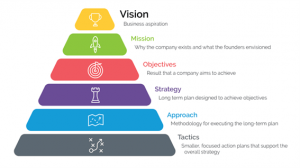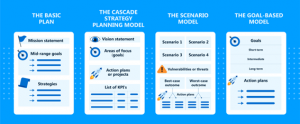
7-step guide for strategic planning
About 90% of all strategic plans fail. Discover why
strategic planning is worth your time and how to do it right.
Every business should have a strategic plan. Yet, many operate without a defined plan or fail to communicate it – a staggering 86% of executive teams spend less than an hour per month discussing strategy, while 95% of workers say they’re in the dark about their organization’s strategic direction. That is probably explains why the vast majority of strategic plans, around 9 out of 10 to be exact, never get fully implemented. Is there a way to make tech strategic planning an effective tool, without spending eye watering sums on consulting fees? Here’s how to do it.
What is strategic planning?
Simply put, strategic planning is figuring out where you want to go in the future, how you’ll get there, and what you’ll need along the way. You’ll need to set some big goals, decide which initiatives are more likely to take you there, make sure you have enough resources to execute and, crucially, follow-up and adjust as you go.

What is strategic plan. Source: Spur reply
If done correctly, strategic planning ensures everyone in the organization knows the destination and is working together to reach it, adjusting plans as needed if there are roadblocks or detours. It’s about being proactive and prepared, rather than just reacting to things as they come.
Is strategic planning worth your time?
With strategic planning, everyone knows exactly where the company is headed and how to get there. Everyone is rowing in the same direction.
Strategic planning also helps you see what could go wrong and make your next move with confidence. It also helps you deploy resources wisely, keep track of your progress and, at the same time, identify areas of success and areas needing improvement.
With strategic planning, everyone knows exactly where the company is headed and how to get there. Everyone is rowing in the same direction.
Strategic planning also helps you see what could go wrong and make your next move with confidence. It also helps you deploy resources wisely, keep track of your progress and, at the same time, identify areas of success and areas needing improvement.

Types of Strategic Plans. Source: slidemodel
Strategic planning doesn’t need to be rigid. In fact, it can serve as a yardstick to adjust your plans when things don’t go as expected to respond to new opportunities or challenges and stay ahead of the competition.
Strategic planning: are there limitations?
Like any tool or approach, strategic planning has its limitations. Firstly, it demands considerable time and resources, particularly for smaller organizations with limited human resources and budget.
Moreover, it relies on assumptions about the future, making it vulnerable to unexpected events or changes in the business environment. Additionally, some plans may become too rigid, hindering adaptability to emerging opportunities or challenges.
Implementation can also pose a significant challenge, as poor execution can undermine the effectiveness of even the most well-crafted plan. Resistance to change from stakeholders comfortable with the status quo can also impede progress.
Furthermore, organizations may risk getting stuck in the planning phase (aka “analysis paralysis”), struggling to transition to action. However, despite these limitations, strategic planning remains a valuable tool for organizations to set goals, navigate challenges, and adapt to change, provided it’s approached with flexibility and a realistic mindset.
What’s more, I believe it’s valuable for planning to involve several members and to be representative of the entire organization. For example, at Near Partner, the company’s mission, vision and values were defined collaboratively with the input of all the members of the different teams. This ensures that we are all aligned in terms of objectives.
Strategic planning: how to do it right
To do strategic planning right, it’s essential to follow a structured approach and consider several key factors.

What should go into a strategic plan. Source: SME strategy
Here’s how to approach it.
Start with clear goals
Before setting off on any strategic plan, gather key data on your current state – including sales and profitability figures, product or category data, market size and growth, new entrants, customer behaviour and trends. Separate what is fact (real data) from is possibly fiction (meaning forecasts or estimates). The more concrete data you gather at this stage, the more effective your strategic plan will be.
Once you’ve gathered this data, gather your team to discuss the results and figure out where do you want to be in the long run and what you aim to accomplish, like “We want to double the sales in sustainable products in three years,” and list the key initiatives to make that happen, like “We need to launch three new products this year”. Your goals will serve as the foundation for your strategic plan.
Potential pitfall to avoid: proposing targets not backed by data.
Conduct a SWOT analysis
Every strategic plan has its roots in a thorough SWOT analysis. Check out your Strengths (what you’re great at), Weaknesses (where you could improve), Opportunities (chances to grow or expand), and Threats (things that could cause trouble). This helps in understanding the current situation and context.
Potential pitfall to avoid: doing it alone, without the inputs from your senior team.
Set priorities and strategies
Focus on high-impact strategies that will move the needle the most toward your objectives. For instance, this could translate into “To hit our sales goal, we’ll start an online marketing campaign, improve our website, and expand our product line.”
Potential pitfall to avoid: listing too many detailed initiatives.
Develop action plans
Once the key initiatives are defined, assign them to someone that has the gravitas to get it done and take responsibility. It is also helpful to set intermediate goals, like a monthly goal to assess the progress of that imitative. An example could be “Next month, we’ll hire a new web designer, launch the marketing campaign, and start developing the new products.”
Potential pitfall to avoid: not assigning owners to tasks and not setting intermediate goals
Allocate resources wisely
Allocate resources, including financial, human, and time resources, effectively to support the implementation of your strategic plan. Ensure they are aligned with your priorities and available to support key initiatives.
Potential pitfall to avoid: having a resource plan separate from your strategy initiatives
Monitor progress and adapt
Keep an eye on how things are going with a formal status meeting at least every week. These meetings should focus on updating your bower chart (or any other visual tool to help you know where you stand as regards to the initial plan).

Strategic bowler chart. Source: KPIFire
Be prepared to adapt your plan as needed in response to changing circumstances or new information.
Potential pitfall to avoid: making strategic planning a once-a-year thing
Communicate effectively
Foster a culture of transparency and accountability to drive engagement and commitment to the plan’s success. Consider sending regular automatic email updates with progress to keep everyone informed.
Near Partner, you partner for strategic planning
Choosing how to put your strategy into action might feel daunting, but it doesn’t have to be. If you need help, we’re here for you with our team of experienced consultants. We can assist you in ensuring that your plan aligns with your organizational culture and is supported by the right implementation approach and resources to bring your vision to life. Reach out today.
Strategic Planning in Action at Near Partner
At our company, we’ve developed a strategic planning process that ensures both high-level vision and operational practicality. This process is structured around three key steps, involving the Leadership Group, the Growth Team, and the entire organization through our all-hands meetings
Leadership Group: Setting the Strategic Vision
The Leadership Group, made up of the organization’s top leaders, is responsible for the initial development of our company’s strategic plan. This group takes a high-level view, considering the internal culture, market trends, competitive positioning and long-term objectives. The group draws up the main strategic initiatives that will drive the company forward, ensuring that the plan is aligned with our mission, vision and values.
Growth Team: Refining and Enhancing the Strategy
Once the Leadership Group has drawn up a draft strategic plan, it is presented to our Growth Team to be refined. The Growth Team is made up of senior management and key individuals who have been with the company the longest, bringing a wealth of experience and institutional knowledge to the table. This team plays a key role in providing feedback, suggesting new ideas and ensuring that the strategy is feasible and grounded in the realities of our business operations.
By involving the Growth Team, we ensure that our strategic plan is not only visionary, but also practical and actionable. This collaborative approach allows us to explore different perspectives, promoting innovation and strengthening the plan before it is finalized.
Company-Wide Monthly Meeting: Sharing the Vision
After the strategic plan is finalized, we ensure that it’s communicated effectively across the entire organization. During our all-hands meeting – Conversa de Pufes, the finalized strategy is presented to all employees. This meeting is a key opportunity to share the vision, explain the strategic initiatives, and discuss how each team’s work will contribute to the company’s overall goals.
This transparent communication process ensures that every employee, regardless of their role, understands the direction the company is headed and how they fit into the bigger picture. It also provides a forum for questions and feedback, fostering a sense of shared purpose and collective responsibility.
The Result: A Strategy Built on Collaboration, Refinement, and Alignment
This three-step approach to strategic planning—starting with the Leadership Group, refining with the Growth Team, and culminating in company-wide communication—ensures that our strategy is both forward-thinking and executable, with buy-in and alignment across the entire organization.





